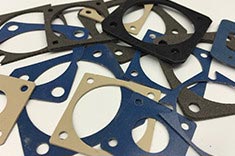EMI Shielding Products
- Custom Gasket Fabrication
- Connector Gaskets
- Bonded O Ring
- Custom Gaskets
- Conduct-O-Knit Knitted Wire Mesh
- Conduct-O-Seal Combo Gasket
- Conduct-O-Elastomer
- Conduct-O-Seal Oriented Wire in Silicone Gasket Material
- Conduct-O-Mesh Tape
- Conduct-O-Foam
- Conduct-O-Bond
- Optical Filters For Electronic Displays
- Shielded Vent Panels
- ESC Board Level Shielding
- 300 Series
Why do Engineers Use EMI RFI Shielding
Before understanding what EMI how EMI shielding works, it is important to understand what EMI is and where it comes from. Electromagnetic interference is something that is all around us, yet we do not directly experience it through our senses. EMI interferes with the performance of electronic devices. What causes these problematic waves?

EMI occurs when two electronic sources disrupt each other's source signals; engineers also refer to EMI as radio frequency interference (RFI). Both EMI and RFI impact the circuits of electrical devices through electrostatic coupling, induction, and conduction. As a result of the varying impacts, the negative effects could be inconsistent performance or, in a worse case, total failure. For smartphones, this could be annoying, but it could be deadly for life-saving medical equipment.
EMI is often broken down into two separate categories, which include:
Broadband EMI – this type of interference occurs over broad spectrums due to occupying a large portion of the electromagnetic spectrum. This is the most dangerous type of EMI, and it is most often experienced when using devices with digital data links.
Narrow-band EMI – this type of interference mostly affects TV stations, radio, and mobile devices. This happens because this type of EMI occurs over discrete frequencies.
Although EMI comes from natural sources like the sun, human-made sources are the most intrusive. Big electronic equipment causes EMI. This includes elevators, heavy machinery, traffic equipment, and HVAC equipment. Even basic communication devices like phones and tablets cause these problems.
EMI RFI Shielding
To defend against EMI and RFI, engineers and designers often turn to EMI RFI shielding. These enclosures protect devices from harmful EMI while also preventing RFI leakage from the device.
Related Reading- How do I Protect Electronic Devices from EMI and CorrosionWhen thinking about EMI RFI shielding, you should also prioritize shielding products that offer corrosion resistance.
- Do My Electronics Require EMI RFI Shielding
- How do I Test EMI RFI Shielding



